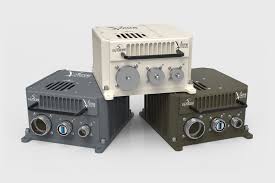
What is Rugged Embedded Computing?
- 0
Welcome to the exciting world of rugged embedded computing! In today’s fast-paced and ever-evolving technological landscape, it has become increasingly important to have robust and reliable systems that can withstand even the harshest environments. That’s where rugged embedded computing comes into play. Imagine a scenario where traditional computers simply wouldn’t survive – extreme temperatures, high levels of vibration, dust-filled atmospheres, or even underwater operations.
Rugged embedded computing is designed specifically to thrive in these challenging conditions, providing uninterrupted performance and ensuring mission-critical tasks are accomplished with ease. In this blog post, we will delve into the history, applications, components, benefits, challenges, and solutions of rugged embedded computing. From military operations to industrial automation and beyond, we’ll explore how this cutting-edge technology is revolutionizing various industries around the globe.
So buckle up as we embark on an intriguing journey through the world of rugged embedded computing – where innovation meets durability! Let’s dive right in and explore what modern technology can do, whether you’re a tech enthusiast or just curious about advanced computer systems that fight all chances.
Applications of Rugged Embedded Computing
Rugged embedded computing has found its way into a wide range of industries and applications, thanks to its durability and reliability in harsh environments. Let’s explore some of the key areas where rugged embedded computing is making an impact.
- Defense Sector: In the defense sector, rugged embedded computing is indispensable for military operations in extreme conditions, managing tasks such as vehicle control, surveillance, and communication.
- Transportation Industry: The transportation industry relies on rugged embedded computing for smooth operations in railways and aviation. These systems monitor critical parameters, ensuring logistics management and passenger safety.
- Industrial Automation: Industrial automation benefits significantly from rugged embedded computing, with systems capable of withstanding harsh conditions in manufacturing processes. They control machinery, monitor production lines, and collect data for analysis.
- Energy Sector: In the energy sector, rugged embedded computers are essential for monitoring performance and preventing failures in diverse environments, from extreme temperatures on oil drilling rigs to constant vibrations in wind turbines.
- Outdoor Recreational Activities: Even in outdoor recreational activities, rugged embedded components in handheld GPS devices endure rough handling during hiking trips or extreme weather conditions during camping adventures.
Key Components of Rugged Embedded Computing
Rugged embedded computing systems are designed to withstand harsh environments and deliver reliable performance in challenging conditions. These systems employ a range of key components that enable them to function seamlessly in demanding applications.
- Processor: Rugged embedded computing systems utilize high-performance processors tailored to specific application requirements, considering factors like speed, power efficiency, and temperature tolerance.
- Memory Modules: Solid-state drives (SSDs) or flash memory are commonly used in rugged embedded systems for reliable data storage. These memory solutions offer durability and resistance to shock, vibration, and extreme temperatures.
- Input/Output (I/O) Interface: The I/O interface facilitates communication between the rugged system and external devices or sensors. Common interfaces include Ethernet ports, USB ports, serial ports (RS-232/RS-485), and GPIO pins for digital signaling.
- Power Management: Robust power supplies capable of handling wide voltage inputs are crucial for rugged embedded systems. Backup power options, such as uninterruptible power supply (UPS) or battery packs, ensure uninterrupted operation during unexpected power outages.
- Thermal Management: Thermal management components, including heat sinks or fans, are integrated to ensure effective cooling. This is essential for maintaining optimal operating temperatures, especially under extreme conditions where powerful processors generate significant heat.
- Protective Enclosures: Protective enclosures are constructed from durable materials like aluminum or composite alloys. These enclosures provide physical protection against dust ingress, water intrusion, and shocks/vibrations caused by impacts or transportation.
In conclusion, the combination of these key components forms the foundation of rugged embedded computing systems, enabling them to deliver reliable performance in harsh and challenging environments across diverse applications. Each component plays a critical role in ensuring durability, resilience, and functionality in the face of extreme conditions.
Benefits of Using Rugged Embedded Computing
Rugged embedded computing offers a myriad of advantages that make it an ideal choice for a wide range of applications.
- Resilience in Harsh Environments: Rugged embedded systems are designed to withstand extreme conditions such as temperature variations, shock, and vibration, ensuring reliable operation in challenging environments.
- Compact Size and Low Power Consumption: The compact size and low power requirements of rugged embedded systems make them suitable for space-constrained environments. Additionally, their low power consumption contributes to extended battery life, making them ideal for portable devices.
- Durability and Reliability: Rugged embedded systems are built with robust components, promoting durability and reliability. This design ensures longevity, minimizes downtime and reduces maintenance costs.
- Enhanced Security Measures: Security features such as encryption and authentication protocols are often incorporated into rugged embedded computers to protect sensitive data from unauthorized access. This is especially crucial in the face of increasing cyber threats.
- High-Performance Capabilities for Real-Time Processing: Rugged embedded computing solutions offer high-performance capabilities, enabling real-time processing and quick response times. This makes them well-suited for critical applications, including military operations and industrial control systems where rapid decision-making is essential.
In conclusion, the benefits of rugged embedded computing span resilience in harsh environments, compact size and low power consumption, durability and reliability, enhanced security measures, and high-performance capabilities for real-time processing. These advantages collectively position rugged embedded systems as versatile and effective solutions across a wide range of applications and industries.
Challenges and Solutions in Rugged Embedded Computing
Building rugged embedded computing systems comes with its fair share of challenges.
1. Harsh Environmental Conditions
- Challenge: Extreme temperatures, shock, vibration, and humidity can damage components.
- Solution: Conformal coating, sturdy enclosures, and impact-resistant designs to protect against moisture, dust, and physical stress.
- Solution: Conformal coating, sturdy enclosures, and impact-resistant designs to protect against moisture, dust, and physical stress.
2. Power Management
- Challenge: Extended operation without access to a stable power source.
- Solution: Intelligent power management algorithms, wide input voltage ranges, and support for alternative power sources like solar panels or batteries.
3. Reliability
- Challenge: Ensuring reliable operation in critical applications.
- Solution: Redundant components or subsystems, robust error detection and correction mechanisms to enhance data integrity.
4. Connectivity
- Challenge: Seamless communication across long distances or interference-prone areas.
- Solution: Advanced communication protocols (Ethernet, Wireless), antenna diversity techniques to improve signal strength, and encryption methods for data security during transmission.
- Solution: Advanced communication protocols (Ethernet, Wireless), antenna diversity techniques to improve signal strength, and encryption methods for data security during transmission.
By implementing these solutions, engineers can build rugged embedded computing systems that not only withstand challenging environmental conditions but also deliver reliable performance in critical applications where failure is not an option.
Real-world Examples Where Rugged Embedded Computing Is Used
- Military Applications: Crucial for military operations, rugged embedded computing ensures uninterrupted performance in harsh environments, from unmanned aerial vehicles to ground-based systems.
- Transportation and Automotive Industry: Widely used for monitoring and controlling critical systems in aircraft, trains, ships, and automobiles, rugged computers withstand vibrations, shocks, and temperature variations, enhancing safety and efficiency.
- Industrial Automation: In manufacturing and oil refineries, rugged embedded systems control complex processes with accuracy, resisting dust, moisture, high temperatures, and electromagnetic interference for reliable operation.
- Healthcare Sector: Applied in healthcare settings, rugged embedded computing ensures flawless operation of medical equipment under demanding conditions, such as patient monitors in emergency response situations.
- Outdoor Exploration: Essential for exploration missions in remote locations, ruggedized computers gather data from sensors deployed in areas like oceans or space exploration missions.
- Transportation Infrastructure Management: Contributes significantly to managing transportation infrastructure through intelligent transportation systems (ITS), collecting data from various sensors for analyzing congestion patterns and optimizing traffic management strategies.
These examples showcase the versatility of rugged embedded computing across diverse industries, meeting the specific demands of each application.
Conclusion
In conclusion, rugged embedded computing stands as a testament to human ingenuity, providing a robust solution for industries navigating challenging environments. From its historical roots to its current evolution, this technology has proven indispensable across diverse sectors. The specialized components not only ensure optimal performance and reliability but also contribute to increased productivity by minimizing downtime.
While challenges in compatibility and thermal management persist, real-world applications underscore its effectiveness in critical operations, reinforcing its role in shaping the future where resilient computing systems will play an increasingly vital role.

